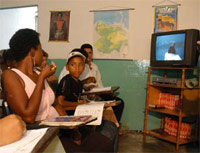Radio and Television

Using television in education.
For much of the past century, radio, and later television, has played a role in education. Traditionally, these forms of ICT have been used in three main ways:
- General educational programming which provides general and informal educational opportunities.
- School broadcasting, where broadcast programming provides supplementary teaching and learning resources not otherwise available.
- Direct class teaching, including Interactive Radio Instruction (IRI) and televised lessons.
IRI consists of broadcasting lessons to classrooms on a daily basis. The radio lessons, on particular topics and aimed at specific levels, provide regular, structured assistance to teachers and serve to improve the quality of teaching and enhance learning. IRI also serves to expand access to education, by bringing ready-made lessons to remote schools and learning centres which have few resources and teachers. Among the Asia-Pacific countries, Thailand was the first to utilize IRI, beginning in 1980. Indonesia, Pakistan, Bangladesh and Nepal implemented IRI projects in the 1990’s. Studies suggest that IRI projects have had a positive impact on both access to and quality of formal and non-formal education. It is also a cost-effective means of delivering educational content to a large number of people.
Televised lessons can be used to supplement other course material or can be stand-alone lessons. Such lessons have progressed over the years from simply being television programmes showing teachers talking, to being more engaging, interactive programmes which incorporate issues relevant to the learners. Educational television programmes are often accompanied by printed materials, CD/DVD ROMs and/or other resources to enhance learning and interaction.
Educational broadcasting is widespread in the Asia-Pacific region. In Japan, for example, the Japanese "University of the Air" broadcasts over 160 television and radio courses. Each course consists of fifteen 45-minute lectures broadcast nationwide once a week over a period of 15 weeks.
Aside from being used for broadcasting specific lessons, radio and television can also be used to broadcast general educational programmes. Basically, any radio or television programme with educational value can be considered a "general educational programme". One example is "Sesame Street" an educational television programme for children from the United States. Another example is the "Farm Radio Forum", a Canadian educational radio discussion forum.
Further information:
• How have radio and TV broadcasting been used in education?
http://www.uva-weblearn.net/radio_and_tv_in_education.asp
• Uses of radio and TV in education
http://www2.unescobkk.org/education/ict/v2_2/detail.asp?id=324000
